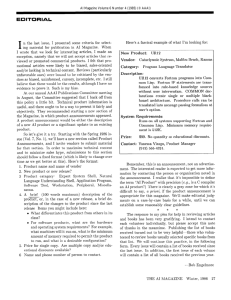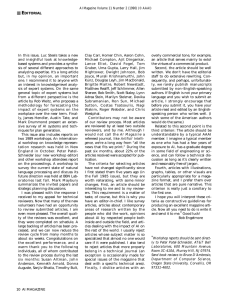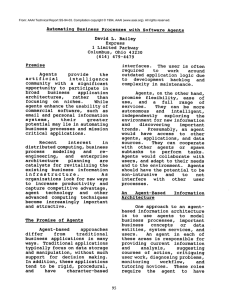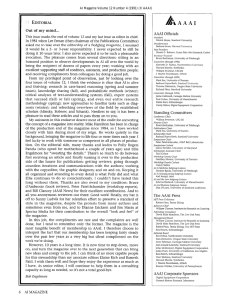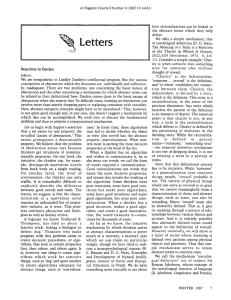EDITORIAL
advertisement
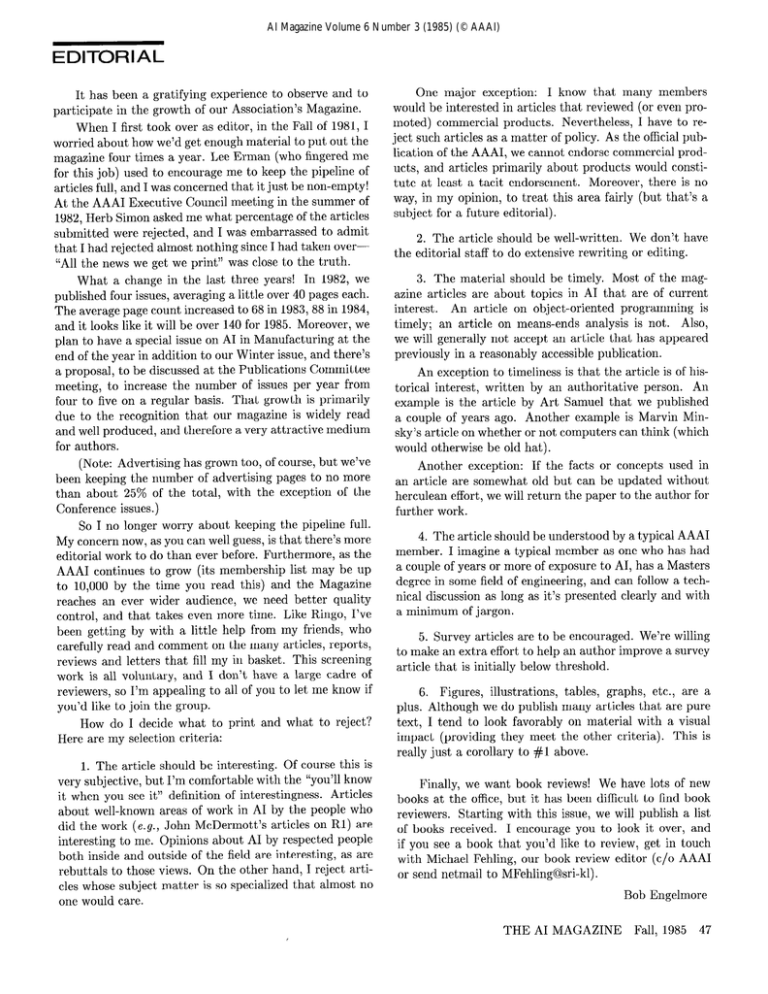
AI Magazine Volume 6 Number 3 (1985) (© AAAI) EDITORIAL It has been a gratifying experience to observe and to participate in the growth of our Association’s Magazine. When I first took over as editor, in the Fall of 1981, I worried about how we’d get enough material to put out the magazine four times a year. Lee Erman (who fingered mc for this job) used to encourage me to keep the pipeline of articles full, and I was concerned that it just be non-empty! At the AAAI Executive Council meeting in the summer of 1982, Herb Simon asked me what percentage of the articles submitted were rejected, and I was embarrassed to admit that I had rejected almost nothing since I had taken over“All the news we get we print” was close to the truth. What a change in the last three years! In 1982, we published four issues, averaging a little over 40 pages each. The average page count increased to 68 in 1983,88 in 1984, and it looks like it will be over 140 for 1985. Moreover, we plan to have a special issue on AI in Manufacturing at the end of the year in addition to our Winter issue, and there’s a proposal, to be discussed at the Publications Committee meeting, to increase the number of issues per year from four to five on a regular basis. That growth is primarily due to the recognition that our magazine is widely read and well produced, and therefore a very attractive medium for authors. (Note: Advertising has grown too, of course, but we’ve been keeping the number of advertising pages to no more than about 25% of the total, with the exception of the Conference issues.) So I no longer worry about keeping the pipeline full. My concern now, as you can well guess, is that there’s more editorial work to do than ever before. Furthermore, as the AAAI continues to grow (its membership list may be up to 10,000 by the time you read this) and the Magazine reaches an ever wider audience, we need better quality control, and that takes even more time. Like Ringo, I’ve been getting by with a little help from my friends, who carefully read and comment on the many articles, reports, reviews and letters that fill my in basket. This screening work is all voluntary, and I don’t have a large cadre of reviewers, so I’m appealing to all of you to let me know if you’d like to join the group. How do I decide what to print and what to reject? Here are my selection criteria: 1. The article should be interesting. Of course this is very subjective, but I’m comfortable with the “you’ll know it when you see it” definition of interestingness. Articles about well-known areas of work in AI by the people who did the work (e.g., John McDermott’s articles on RI) are interesting to me. Opinions about AI by respected people both inside and outside of the field are interesting, as are rebuttals to those views. On the other hand, I reject articles whose subject matter is so specialized that almost no one would care. One major exception: I know that many members would be interested in articles that reviewed (or even promoted) commercial products. Nevertheless, I have to reject such articles as a matter of policy. As the official publication of the AAAI, we cannot endorse commercial products, and articles primarily about products would constitute at least a tacit endorsement. Moreover, there is no way, in my opinion, to treat this area fairly (but that’s a subject for a future editorial). 2. The article should be well-written. We don’t have the editorial staff to do extensive rewriting or editing. 3. The material should be timely. Most of the magazine articles are about topics in AI that are of current interest. An article on object-oriented programming is timely; an article on means-ends analysis is not. Also, we will generally not accept an article that has appeared previously in a reasonably accessible publication. An exception to timeliness is that the article is of historical interest, written by an authoritative person. An example is the article by Art Samuel that we published a couple of years ago. Another example is Marvin Minsky’s article on whether or not computers can think (which would otherwise be old hat). Another exception: If the facts or concepts used in an article are somewhat old but can be updated without herculean effort, we will return the paper to the author for further work. 4. The article should be understood by a typical AAAI member. I imagine a typical member as one who has had a couple of years or more of exposure to AI, has a Masters degree in some field of engineering, and can follow a technical discussion as long as it’s presented clearly and with a minimum of jargon. 5. Survey articles are to be encouraged. We’re willing to make an extra effort to help an author improve a survey article that is initially below threshold. 6. Figures, illustrations, tables, graphs, etc., are a plus. Although we do publish many articles that are pure text, I tend to look favorably on material with a visual impact (providing they meet the other criteria). This is really just a corollary to #l above. Finally, we want book reviews! We have lots of new books at the office, but it has been difficult to find book reviewers. Starting with this issue, we will publish a list of books received. I encourage you to look it over, and if you see a book that you’d like to review, get in touch with Michael Fehling, our book review editor (c/o AAAI or send netmail to MFehling@sri-kl). Bob Engelmore THE AI MAGAZINE Fall, 1985 47
